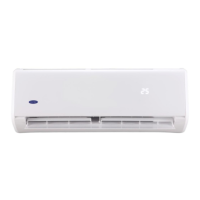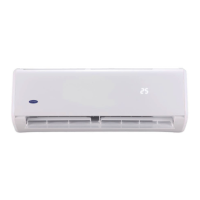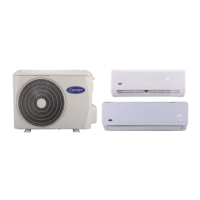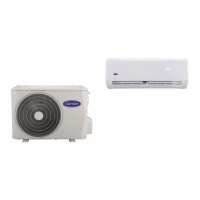10
09
C
heck if the height difference between indoor unit & outdoor unit and the total length of refrigerant pipe meet
system requirement.
Refrigerant piping work follows the indoor unit and outdoor unit installation, connect the pipe at the indoor side first,
then the outdoor side.
Always keep ends of tubing sealed by placing a cap or covering with tape during installation and do NOT remove
them until you are ready to connect the piping.
Be sure to insulate any field piping all the way to the piping connection inside the unit. Any exposed piping may
cause condensation or burns if touched.
When the outdoor unit is the top position and the difference of level is over 10m, it is recommended that set
a oil return bend every 5~8m in the gas pipe. The radius of oil reture bend should be over than 10cm.
CAUTION
4.1 FLARING
NOTE
Tools required for flaring are pipe cutter, reamer, flaring
tool and pipe holder.
90
Oblique Rough Burr
R0.4~0.8
45
°
±
2
90
°
±
4
A
In case of needing brazing, work with Nitrogen gas blowing.
Improper torque will cause flare damage or gas leaks.
CAUTION
Use separate thermal insulation pipes for gas & liquid pipes.
The thickness above is a standard of the indoor temperature
of 27°C and humidity of 80%. If installing in an unfavorable
conditions such as near bathrooms, kitchens, and other similar
locations, reinforce the insulation.
Insulation’s heat-resistance temperature should be more than
120°C.
Use the adhesives on the connection part of insulation to
prevent moisture from entering.
Repair and cover any possible cracks in the insulation, specially
check the bent part or hanger of pipe.
Before installation, check strength and horizontality of the base so that abnormal sound does not generate.
Fix the base firmly with anchor bolts (M10) to prevent it from collapsing.
Install the foundation and vibration-proof rubbers to directly support the bottom surface of the fixing leg that
is in contact with the bottom plate of the outdoor unit.
3.4 INSTALL THE OUTDOOR UNIT
≥100mm
100~300mm
Outdoor unit
Vibration-proof rubber
Anchor bolt (M10)
Drainage (Wide 100mm x Depth 150mm)Mortar Hole (Φ100mm x Depth 150mm)
4.1.1 Using a pipe cutter to cut the pipe to the requested
length. Ensure that the cut edge remains at 90° with
the side of the pipe.
4.1.2 Use a reamer to remove burrs with the cut surface
downward so that the chips do not enter the pipe.
4.1.3 Carry out flaring work using flaring tools as below.
4.1.4 Check if the flaring is properly made. See incorrectly
flared pipes sample below.
4.2 PIPING WORK
4.2.1 Align the center to tighten the flare nut and finish
connection using two wrenches.
Flare nut
Wrench
Torque wrench
4.2.2 Select the appropriate insulation material for refrigerant
pipe. (Min. 10mm, thermal insulating foam C)
Connect the drain outlet with an extension drain hose
Fit the gasket onto drain outlet.
Insert the drain outlet into the base pan hole of outdoor unit, and rotate 90 degree to securely assemble them.
3.5 INSTALL THE DRAIN PIPE FOR OUTDOOR UNIT
Inclined Damaged Surface Cracked Uneven Thickness
Base pan hole
of outdoor unit
Drain hose
(Field supply)
Gasket
Drain Outlet
TorqueTubing size
18 ~ 20 N.m
25 ~ 26 N.m
35 ~ 36 N.m
45 ~ 47 N.m
65 ~ 67 N.m
Φ6.35mm
Φ9.52mm
Φ12.7mm
Φ15.88mm
Φ19.05mm
Outside diameter
A(mm)
Max
8.7Φ6.35mm
Φ9.52mm
Φ12.7mm
Φ15.88mm
Φ19.05mm
12.4
15.8
19.0
23.3
8.3
12.0
15.4
18.6
22.9
Min
3.3 OUTDOOR WIRE CONNECTION
Remove the electrical cover and cable clamp by loosening the screws.
Connect wires to the outdoor terminal block by same sequence to indoor unit.
Electric cover
Wire downwards to prevent
water entering control box.
L N
S
Terminal Block
Cable Clamp
3. OUTDOOR UNIT INSTALLATION
4. REFRIGERANT PIPING WORK
G B
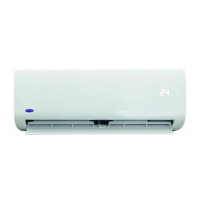
